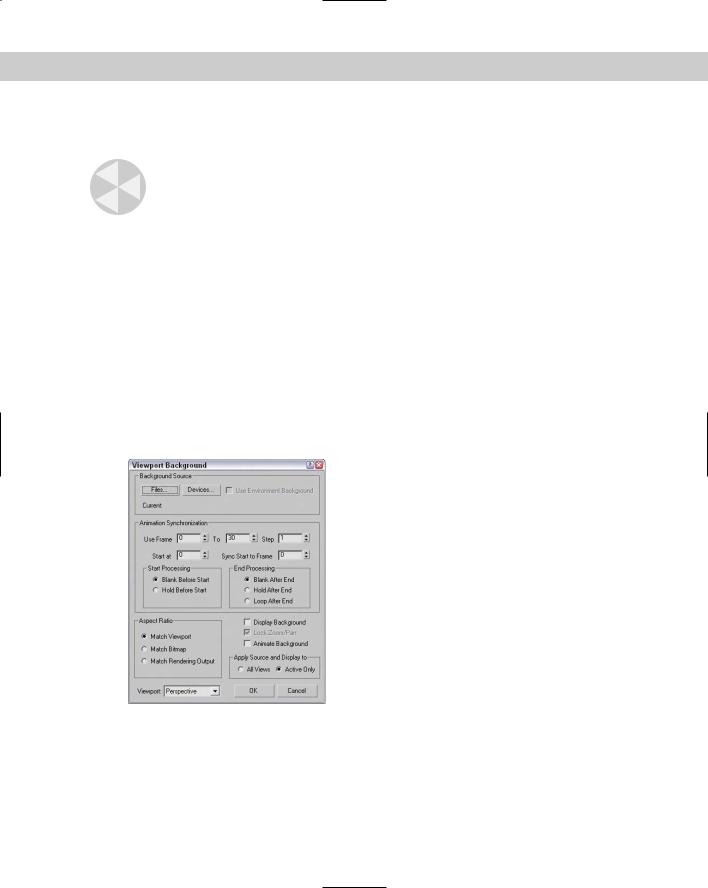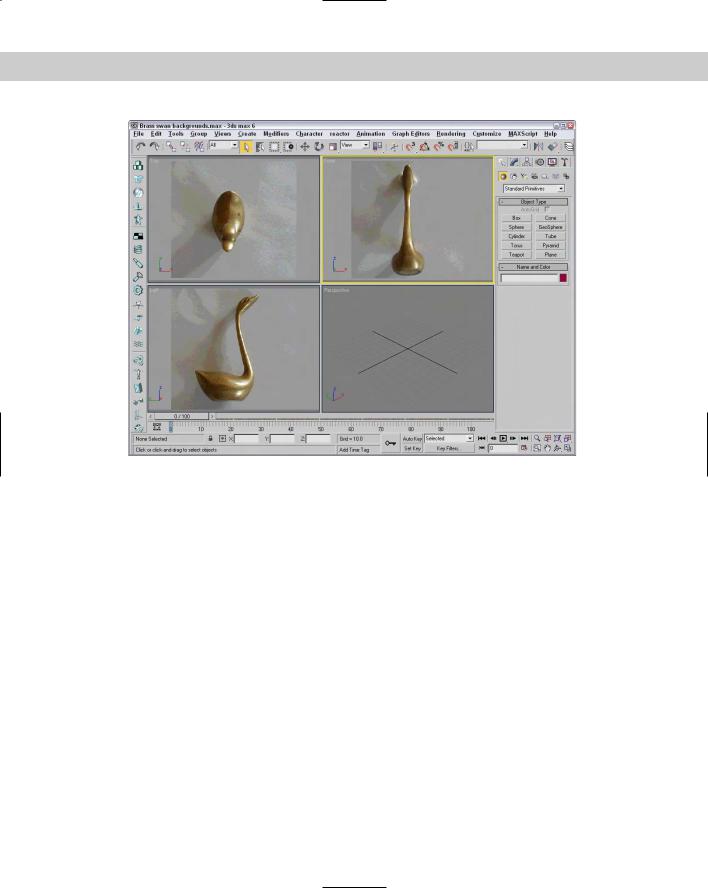
- •Preface
- •About This Book
- •Acknowledgments
- •Contents at a Glance
- •Contents
- •Relaxing at the Beach
- •Dressing the Scene
- •Animating Motion
- •Rendering the Final Animation
- •Summary
- •The Interface Elements
- •Using the Menus
- •Using the Toolbars
- •Using the Viewports
- •Using the Command Panel
- •Using the Lower Interface Bar Controls
- •Interacting with the Interface
- •Getting Help
- •Summary
- •Understanding 3D Space
- •Using the Viewport Navigation Controls
- •Configuring the Viewports
- •Working with Viewport Backgrounds
- •Summary
- •Working with Max Scene Files
- •Setting File Preferences
- •Importing and Exporting
- •Referencing External Objects
- •Using the File Utilities
- •Accessing File Information
- •Summary
- •Customizing Modify and Utility Panel Buttons
- •Working with Custom Interfaces
- •Configuring Paths
- •Selecting System Units
- •Setting Preferences
- •Summary
- •Creating Primitive Objects
- •Exploring the Primitive Object Types
- •Summary
- •Selecting Objects
- •Setting Object Properties
- •Hiding and Freezing Objects
- •Using Layers
- •Summary
- •Cloning Objects
- •Understanding Cloning Options
- •Mirroring Objects
- •Cloning over Time
- •Spacing Cloned Objects
- •Creating Arrays of Objects
- •Summary
- •Working with Groups
- •Building Assemblies
- •Building Links between Objects
- •Displaying Links and Hierarchies
- •Working with Linked Objects
- •Summary
- •Using the Schematic View Window
- •Working with Hierarchies
- •Setting Schematic View Preferences
- •Using List Views
- •Summary
- •Working with the Transformation Tools
- •Using Pivot Points
- •Using the Align Commands
- •Using Grids
- •Using Snap Options
- •Summary
- •Exploring the Modifier Stack
- •Exploring Modifier Types
- •Summary
- •Exploring the Modeling Types
- •Working with Subobjects
- •Modeling Helpers
- •Summary
- •Drawing in 2D
- •Editing Splines
- •Using Spline Modifiers
- •Summary
- •Creating Editable Mesh and Poly Objects
- •Editing Mesh Objects
- •Editing Poly Objects
- •Using Mesh Editing Modifiers
- •Summary
- •Introducing Patch Grids
- •Editing Patches
- •Using Modifiers on Patch Objects
- •Summary
- •Creating NURBS Curves and Surfaces
- •Editing NURBS
- •Working with NURBS
- •Summary
- •Morphing Objects
- •Creating Conform Objects
- •Creating a ShapeMerge Object
- •Creating a Terrain Object
- •Using the Mesher Object
- •Working with BlobMesh Objects
- •Creating a Scatter Object
- •Creating Connect Objects
- •Modeling with Boolean Objects
- •Creating a Loft Object
- •Summary
- •Understanding the Various Particle Systems
- •Creating a Particle System
- •Using the Spray and Snow Particle Systems
- •Using the Super Spray Particle System
- •Using the Blizzard Particle System
- •Using the PArray Particle System
- •Using the PCloud Particle System
- •Using Particle System Maps
- •Controlling Particles with Particle Flow
- •Summary
- •Understanding Material Properties
- •Working with the Material Editor
- •Using the Material/Map Browser
- •Using the Material/Map Navigator
- •Summary
- •Using the Standard Material
- •Using Shading Types
- •Accessing Other Parameters
- •Using External Tools
- •Summary
- •Using Compound Materials
- •Using Raytrace Materials
- •Using the Matte/Shadow Material
- •Using the DirectX 9 Shader
- •Applying Multiple Materials
- •Material Modifiers
- •Summary
- •Understanding Maps
- •Understanding Material Map Types
- •Using the Maps Rollout
- •Using the Map Path Utility
- •Using Map Instances
- •Summary
- •Mapping Modifiers
- •Using the Unwrap UVW modifier
- •Summary
- •Working with Cameras
- •Setting Camera Parameters
- •Summary
- •Using the Camera Tracker Utility
- •Summary
- •Using Multi-Pass Cameras
- •Creating Multi-Pass Camera Effects
- •Summary
- •Understanding the Basics of Lighting
- •Getting to Know the Light Types
- •Creating and Positioning Light Objects
- •Viewing a Scene from a Light
- •Altering Light Parameters
- •Working with Photometric Lights
- •Using the Sunlight and Daylight Systems
- •Using Volume Lights
- •Summary
- •Selecting Advanced Lighting
- •Using Local Advanced Lighting Settings
- •Tutorial: Excluding objects from light tracing
- •Summary
- •Understanding Radiosity
- •Using Local and Global Advanced Lighting Settings
- •Working with Advanced Lighting Materials
- •Using Lighting Analysis
- •Summary
- •Using the Time Controls
- •Working with Keys
- •Using the Track Bar
- •Viewing and Editing Key Values
- •Using the Motion Panel
- •Using Ghosting
- •Animating Objects
- •Working with Previews
- •Wiring Parameters
- •Animation Modifiers
- •Summary
- •Understanding Controller Types
- •Assigning Controllers
- •Setting Default Controllers
- •Examining the Various Controllers
- •Summary
- •Working with Expressions in Spinners
- •Understanding the Expression Controller Interface
- •Understanding Expression Elements
- •Using Expression Controllers
- •Summary
- •Learning the Track View Interface
- •Working with Keys
- •Editing Time
- •Editing Curves
- •Filtering Tracks
- •Working with Controllers
- •Synchronizing to a Sound Track
- •Summary
- •Understanding Your Character
- •Building Bodies
- •Summary
- •Building a Bones System
- •Using the Bone Tools
- •Using the Skin Modifier
- •Summary
- •Creating Characters
- •Working with Characters
- •Using Character Animation Techniques
- •Summary
- •Forward versus Inverse Kinematics
- •Creating an Inverse Kinematics System
- •Using the Various Inverse Kinematics Methods
- •Summary
- •Creating and Binding Space Warps
- •Understanding Space Warp Types
- •Combining Particle Systems with Space Warps
- •Summary
- •Understanding Dynamics
- •Using Dynamic Objects
- •Defining Dynamic Material Properties
- •Using Dynamic Space Warps
- •Using the Dynamics Utility
- •Using the Flex Modifier
- •Summary
- •Using reactor
- •Using reactor Collections
- •Creating reactor Objects
- •Calculating and Previewing a Simulation
- •Constraining Objects
- •reactor Troubleshooting
- •Summary
- •Understanding the Max Renderers
- •Previewing with ActiveShade
- •Render Parameters
- •Rendering Preferences
- •Creating VUE Files
- •Using the Rendered Frame Window
- •Using the RAM Player
- •Reviewing the Render Types
- •Using Command-Line Rendering
- •Creating Panoramic Images
- •Getting Printer Help
- •Creating an Environment
- •Summary
- •Creating Atmospheric Effects
- •Using the Fire Effect
- •Using the Fog Effect
- •Summary
- •Using Render Elements
- •Adding Render Effects
- •Creating Lens Effects
- •Using Other Render Effects
- •Summary
- •Using Raytrace Materials
- •Using a Raytrace Map
- •Enabling mental ray
- •Summary
- •Understanding Network Rendering
- •Network Requirements
- •Setting up a Network Rendering System
- •Starting the Network Rendering System
- •Configuring the Network Manager and Servers
- •Logging Errors
- •Using the Monitor
- •Setting up Batch Rendering
- •Summary
- •Compositing with Photoshop
- •Video Editing with Premiere
- •Video Compositing with After Effects
- •Introducing Combustion
- •Using Other Compositing Solutions
- •Summary
- •Completing Post-Production with the Video Post Interface
- •Working with Sequences
- •Adding and Editing Events
- •Working with Ranges
- •Working with Lens Effects Filters
- •Summary
- •What Is MAXScript?
- •MAXScript Tools
- •Setting MAXScript Preferences
- •Types of Scripts
- •Writing Your Own MAXScripts
- •Learning the Visual MAXScript Editor Interface
- •Laying Out a Rollout
- •Summary
- •Working with Plug-Ins
- •Locating Plug-Ins
- •Summary
- •Low-Res Modeling
- •Using Channels
- •Using Vertex Colors
- •Rendering to a Texture
- •Summary
- •Max and Architecture
- •Using AEC Objects
- •Using Architectural materials
- •Summary
- •Tutorial: Creating Icy Geometry with BlobMesh
- •Tutorial: Using Caustic Photons to Create a Disco Ball
- •Summary
- •mental ray Rendering System
- •Particle Flow
- •reactor 2.0
- •Schematic View
- •BlobMesh
- •Spline and Patch Features
- •Import and Export
- •Shell Modifier
- •Vertex Paint and Channel Info
- •Architectural Primitives and Materials
- •Minor Improvements
- •Choosing an Operating System
- •Hardware Requirements
- •Installing 3ds max 6
- •Authorizing the Software
- •Setting the Display Driver
- •Updating Max
- •Moving Max to Another Computer
- •Using Keyboard Shortcuts
- •Using the Hotkey Map
- •Main Interface Shortcuts
- •Dialog Box Shortcuts
- •Miscellaneous Shortcuts
- •System Requirements
- •Using the CDs with Windows
- •What’s on the CDs
- •Troubleshooting
- •Index

84 |
Part I Learning the Max Interface |
Once enabled, you can use the divide key (/) on the numeric keypad to turn the virtual viewport on and off. Use the plus (+) and minus (-) numeric keypad keys to zoom in and out, and use the 2, 4, 6, and 8 keys on the numeric keypad to pan within the virtual viewport.
Caution |
The Virtual Viewport feature is available only if you are using the OpenGL driver. If you’ve |
|
specified either the Software Z-Buffer or the Direct X driver, then this option isn’t available. |
Working with Viewport Backgrounds
Remember in grade school when you realized that you could immediately draw really well using tracing paper (where all you needed to do was follow the lines)? Well, it’s not quite tracing paper, but you can load background images into a viewport that can help as you create and position your objects.
Loading viewport background images
The Views Viewport Background menu command (Alt+B) opens a dialog box, shown in Figure 2-22, where you can select an image or animation to appear behind a viewport. The displayed background image is helpful for aligning objects in a scene, but it is for display purposes only and will not be rendered. To create a background image to be rendered, you need to specify the background in the Environment dialog box, opened using the Rendering Environment (keyboard shortcut, 8) menu command.
Figure 2-22: The Viewport Background dialog box lets you select a background source image or animation.

Chapter 2 Seeing It All — Working with the Viewports |
85 |
|
If the background image changes, you can update the viewport using the Views Update |
|
Background Image menu command (Alt+Shift+Ctrl+B). This is helpful if you have the back- |
|
ground image opened in Photoshop at the same time. You can update the background image, |
|
save it, and then immediately update the image in Max. The Views Reset Background |
|
Transform menu command automatically rescales and recenters the background image to |
|
fit the viewport. You should use this if you’ve changed the viewport size or changed the |
|
background’s size. |
|
Each viewport can have a different background image. To load and configure a viewport back- |
|
ground image, choose Views Viewport Background (or press the Alt+B keyboard shortcut). |
|
This opens the Viewport Background dialog box, shown previously. |
|
The Files button opens the Select Background Image dialog box, where you can select the |
|
image to load. The Devices button lets you obtain a background from a device such as a |
|
Video Recorder. If an environment map is already loaded into the Environment dialog box, |
|
you can simply click the Use Environment Background option. Keep in mind that the back- |
|
ground image will not be rendered unless it is made into an Environment map. |
Cross- |
I cover environment maps in Chapter 41, “Rendering Basics.” |
Reference |
|
|
Loading viewport background animations |
|
The Animation Synchronization section of the Viewport Background dialog box lets you set |
|
which frames of a background animation sequence are displayed. The Use Frame and To val- |
|
ues determine which frames of the loaded animation are used. The Step value trims the num- |
|
ber of frames that are to be used by selecting every Nth frame. For example, a Step value of 4 |
|
would use every fourth frame. |
Tip |
Loading an animation sequence as a viewport background can really help as you begin to |
|
animate complex motions, like a running horse. By stepping through the frames of the ani- |
|
mation, you can line up your model with the background image for realistic animations. |
|
The Start At value is the frame in the current scene where this background animation would |
|
first appear. The Sync Start to Frame value is the frame of the background animation that |
|
should appear first. The Start and End Processing options let you determine what appears |
|
before the Start and End frames. Options include displaying a blank, holding the current |
|
frame, and looping. |
|
If you select an animation as the background, make sure that the Animate Background option |
|
is selected. Also note that the viewport background is not visible if the Display Background |
|
option is not selected. |

86 |
Part I Learning the Max Interface |
The Aspect Ratio section offers options for setting the size of the background image. You can select to Match Viewport, Match Bitmap, or Match Rendering Output.
The Lock Zoom/Pan option is available if either the Match Bitmap option or the Match Rendering Output option is selected. This option locks the background image to the geometry so that when the objects in the scene are zoomed or panned, the background image follows. If the background gets out of line, you can reset its position with the Views Reset Background Transform command.
Caution |
When the Lock Zoom/Pan option is selected, the background image is resized when you |
|
zoom in on an object. Resizing the background image fills the virtual memory, and if you |
|
zoom in too far, the background image could exceed your virtual memory. If this happens, a |
|
dialog box appears that informs you of the problem and gives you the option of not display- |
|
ing the background image. |
You can set the Apply Source and Display to option to display the background in All Views or in the Active Only.
Tutorial: Loading reference images for modeling
When modeling a physical object, you can get a jump on the project by taking pictures with a digital camera of the front, top, and left views of the object and then load them as background images in the respective viewports. The background images can then be a reference for your work. This is especially helpful with models that need to be precise. You can even work from CAD drawings.
To load the background images of a brass swan, follow these steps:
1.Choose File New (or press Ctrl+N) to open a blank scene file.
2.Right-click on the Front viewport to make it the active viewport, and choose Views Viewport Background (or press Alt+B).
The Viewport Background dialog box opens.
3.Click on the Files button, and in the File dialog box that opens, select the Brass swanfront view.jpg image from the Chap 02 directory on the CD-ROM.
4.Select the Match Bitmap, Display Background, Lock Zoom/Pan, and Active Only options, and click OK to close the dialog box.
The image now appears in the background of the Front viewport.
5.Repeat Steps 2 through 4 for the Top and Left viewports.
Figure 2-23 shows the Max interface with background images loaded in the Front, Top, and Left viewports.

Chapter 2 Seeing It All — Working with the Viewports |
87 |
Figure 2-23: Adding a background image to a viewport can help as you begin to model objects.
Summary
Viewports are the window into the Max world. Remember that if you can’t see it, you can’t work with it, so you need to learn to use the viewports. You can also configure viewports to display just the way you desire.
In this chapter, you
Learned about 3D space and the various viewport types
Covered the various Viewport Navigation Control buttons
Set the Rendering Level and Display options in the Viewport Configuration dialog box
Used the other panels of the Viewport Configuration dialog box to change the layout, safe frames, and regions

88 |
Part I Learning the Max Interface |
Learned how you can use Adaptive Degradation to maintain a constant frame rate for viewport animation sequences
Loaded a viewport background image
In the next chapter, you find out all the details about working with files, including loading, saving, and merging scene files. You also learn about External References (XRefs) and how to use them to manage scene creation in a workgroup. The next chapter also covers import and export options for interfacing with other software packages.
|
|
|
